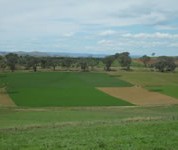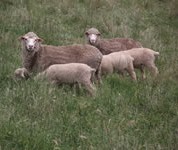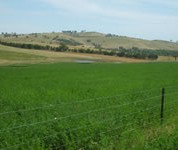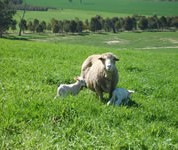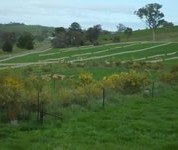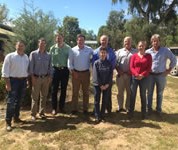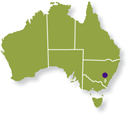Key Results
Click on the key result heading to see full information.
Perennial persistence
- Phalaris, tall fescue and lucerne established during a drought managed to persist, and subsequently improve after the drought
- Groundcover was maintained above 70% most of the time in all pasture types and with different livestock systems. Lower groundcover was more frequent in lucerne pastures during autumn.
Lucerne
- In the dry years there was no difference in lamb production between systems with 20% compared to 40% of pastures sown to lucerne. In wet spring/summers the system with 40% lucerne allowed lambs to be retained longer resulting in 168 kg/ha more lamb produced compared to the 20% lucerne.
- Supplementary feed costs were reduced in drought years in the 40% lucerne system compared to 20% lucerne.
- Gross margins were slightly higher in most drought years in the 40% lucerne treatment, but were significantly higher (by $264/ha) in the years with wet spring/summers as a result of higher lamb production compared to the 20% lucerne system in those years.
- Flexible animal enterprises enabled extra feed to be profitably captured and are necessary for opportunistic use of lucerne.
Livestock systems
- Modelling showed that using perennial rather than annual pastures with a Merino system increased profit, largely because perennials allowed a later lambing time so a higher ewe stocking rate. Profit was increased further if a portion of the Merino ewes produced crossbred rather than Merino lambs.
- On the perennial pasture base (lucerne, phalaris and tall fescue) at the experimental site, a Later (September) Lambing system carried nearly twice as many ewes/ha as a Winter (July) Lambing Merino even though they had the same mid-winter stocking rate. A Split Lambing system was midway between the two.
- Although the higher number of ewes in the Later Lambing system resulted in more lambs born, these lambs did not grow well in the dry springs (2006-2009) and the resulting production (kg/ha) was similar to the Winter Lambing Merino and lower than the Split Lambing system in most years.
- Lower numbers of ewes and lambs in the Winter Lambing Merino and Split Lambing systems meant that in a wet year, lambs could be retained for longer and grown to heavier weights (on lucerne) than in the Later Lambing system, before pasture supply became limiting.
- Higher lamb growth rates from crossbred lambs together with higher stocking rates meant that the Split Lambing system produced more lamb than the Winter Lambing Merino, especially in the wet year.
- The Later Lambing system produced 64% to 106% more clean wool/ha than the Winter Lambing Merino system.
- The quantity of supplementary feeding through the dry springs was driven by stocking rate and ability to vary stocking rate such that at $300/tonne for grain, the Later Lambing system spent $105-$333/ha more than the Winter Lambing Merino system and $92-$130/ha more than the Split Joining system in each year.
- While modelling indicated Later Lambing would produce higher gross margins than the Winter Lambing Merino in the long term, high supplementary feeding costs in the dry years resulted in lower gross margins in those years.
- The Split Lambing system performed as well or better than the Winter Lambing Merino system in poor years, but had the capacity to be more productive in the wet year, resulting in a gross margin $156/ha greater than the Winter Lambing Merino and $104/ha greater than the Later Lambing system in that year.
- Post-experimental modelling using the last 40 years of rainfall data suggests that Spring Lambing resulted in higher average gross margin but also a greater range in gross margin than Winter Lambing. Type of sire (merino or terminal) had a smaller effect on average gross margin than choice of lambing time.
Flushing on green feed
- Flushing on green feed increased ovulation rates by an average of 10% but up to 22% in synchronised ewes. In on-farm trials, flushing unsynchronised autumn joined ewes on green feed resulted in an average of 16 more foetuses per 100 ewes joined (as a result of additional multiple pregnancies). This was estimated to result in an additional 10 lambs per 100 ewes joined. At 7 ewes/ha, this results in a return of $48/ha from the additional lambs sold.
- For flushing, the live pasture needed to be of high quality and adequate quantity. Flushing was achieved on as little as 350kgDM/ha of green lucerne.
- The return from using green feed for flushing ewes compared to finishing lambs or growing out weaners varied depending on the available green feed and the market price for lambs and supplementary feed.
Shrubs and lucerne for controlling recharge
- Shrub belts used more water than annual pastures and therefore created a small dry soil buffer in the area where they were planted. However, the area sown to shrubs was not large enough to significantly reduce soil moisture at the foot of the slope.
- Lucerne and the shrubs used similar quantities of water, and because lucerne was sown throughout the paddock, it had a significant effect on soil water at the foot of the slope.
- Soil moisture in the pasture areas between the shrub belts was largely unaffected and therefore had no impact on pasture growth, but no recharge control either.
Shelter for lambing ewes
- While at the Hamilton Proof Site a 30% increase in lamb survival (at average birthweight) was achieved by lambing in grass hedgerows compared to shelter, the benefit at Wagga Wagga (where wind chill was lower) was much smaller.
- Survival in 2008-09 was 10% higher (77%) for twin lambs born in shrub shelter compared to hessian rows (70%). Phalaris hedgerows were ineffective in 2006-07 because ewes ate them and they did not regenerate after drought.
- Survival of twins sheltered by hessian rows was reduced at high (30 ewes/ha, 63% survival) compared to low (16 ewes/ha, 83% survival) stocking rates in 2010.
Publications
Presentation
Flushing on green feed powerpoint
What’s the most profitable way to use limited green feed this summer? This powerpoint demonstration takes you through the various scenarios of utilis…
Read MoreKate Sargeant, Michael Friend, Laura Garland, Susan Robertson; 2013; EverGraze
Report
EverGraze Impact Report – June 2011 to June 2012
The purpose of this report is to summarise the Impact of the EverGraze project based on evaluation data collected from activities between July 2011 an…
Read MoreEverGraze; 2012; EverGraze
Tool
Shelter For Lambing Tool
At the Hamilton and Wagga Wagga Proof Sites, perennial grass hedges and shrub nurseries provided very effective shelter, reducing wind chill by up to…
Read MoreMcCaskill M, Beattie L; 2013; EverGraze
Fact sheet
EverGraze Exchange – Shrub belt hedges for shelter and recharge control
The most obvious benefit of belts of shrubs is to shelter stock from cold and wet weather that can cause livestock deaths, especially of new born lamb…
Read MoreHume I, Ebberbach P, Condon J; 2011; EverGraze
Webpage
EverGraze Exchange – Livestock Systems (Online)
This Online EverGraze Exchange provides information on the key factors driving livestock productivity and enterprise profitability. A process is inclu…
Read MoreKate Sargeant, Geoff Saul, Ralph Behrendt, Michael Friend, Paul Sanford; 2013; EverGraze, Future Farm Industries CRC
Tool
EverGraze Green Feed Allocation Tool
Research at Wagga Wagga showed that flushing ewes by grazing them on green feed (such as lucerne) for one week prior and one weeks during joining coul…
Read MoreLaura Garland, Kate Sargeant, Lee Beattie;
Report
Tactical Management Regimes Report on Simulation Modelling at Wagga Wagga
The experiment at the Wagga Wagga Proof site at Tarcutta conducted by EverGraze between 2006 and 2010 was subject to either drought or extremely wet y…
Read MoreRobertson S; 2012; EverGraze
Conference paper
Split joining of Merino ewes creates flexibility in a variable climate
Merino producers can achieve flexibility and reduced risk in their ewe operations by adopting a split joining strategy. Conservative lamb producers in…
Read MoreMeckiff J, Friend MA; 2009; ‘Proceedings of the 50th Annual Conference of the Grassland Society of Southern Australia’ p.209-212
Conference paper
Choice of sheep enterprise affects production and risk
To access this resource you will need to be a member of the website on which this resource is held
Read MoreRobertson SM, Friend MA; 2012; Proceedings of the 27th Annual Conference of the Grassland Society of NSW, 24-26 July 2012, Wagga Wagga, New South Wales (The Grassland Society of NSW Inc. , Orange), p 135-137
Journal article
Ewe and lamb contact at lambing is influenced by both shelter type and birth number
A significant number of lambs born each year in Australia die within 72 h of birth. Periods of high wind, combined with rain and low temperatures can…
Read MoreBroster JC, Dehaan RL, Swain DL, Friend MA; 2010; Animal, 4(5), 796-803

